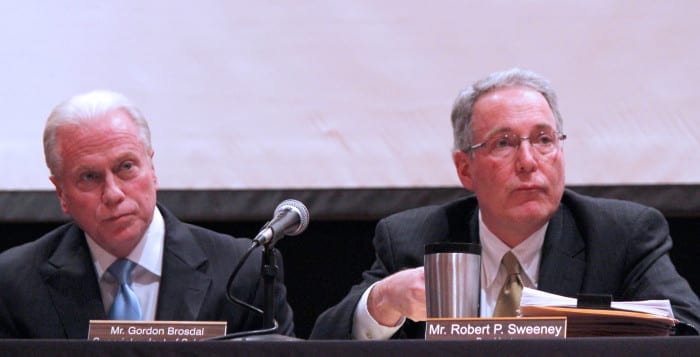Mount Sinai school board adopts $56.7 million budget
Full-day kindergarten included in spending plan

Over the last four years, only an average of 17 percent of registered voters in the Mount Sinai school district came out to the district’s annual May budget and school board election. This year, Superintendent Gordon Brosdal is urging residents to actually show up to the polls.
Prior to making his last presentation on the district’s proposed $56.7 million 2015-16 school year budget, which the school board unanimously adopted, Brosdal took a few minutes to remind the larger-than-usual crowd that every vote matters.
“If people vote yes or no, that’s their issue, but please come out and vote,” he said at the April 22 school board meeting. “All of you. Encourage your friends, neighbors.”
Elected officials, those who decide how much state aid the district gets, will take notice, according to Brosdal.
While the district budgeted for no increase in state aid over the current year, the district received $391,860 more than anticipated. Included in the total $16.4 million aid package, is more than $500,000 in kindergarten conversion aid, as the district plans to transition from a half-day to full-day kindergarten program.
The possible change has been a topic of discussion for a year, with many parents backing the move, as students require additional classroom time in order to keep up with the Common Core Learning Standards.
Last month, the district committed to making the jump and included the full-day program in its budget proposal.
At the April 22 meeting, Brosdal said that after he recently saw Miller Place’s newly implemented full-day kindergarten program he was “kind of elated” by what he witnessed at the school and how much the students were learning.
“We are leaving kids behind in our current program,” Brosdal said.
But school officials have repeatedly reminded residents that the budget just isn’t about kindergarten. There is still a whole K-12 program that the budget maintains and betters.
Under the spending plan, which increases nearly 3.3 percent from the current year, class sizes, class offerings and programs are maintained. In addition, the district will begin following Columbia University’s Teachers College Writing Project, which provides writing curriculum and professional development for teachers, in grades kindergarten through fifth.
A resident with an average assessed home value of $3,500 will see an annual tax increase of $156.
The slight increase in state aid also helps the district’s three-year outlook, as it won’t have to rely as much on appropriating fund balance year after year. In the past, board President Robert Sweeney pointed to the 2017-18 school year as to when the district’s surplus would be depleted. However, according to current district estimates, the fund balance would remain at nearly 2 percent of the operating budget that year.
“We’re now in a position that we can develop our program each year and develop our program positively,” he said.






